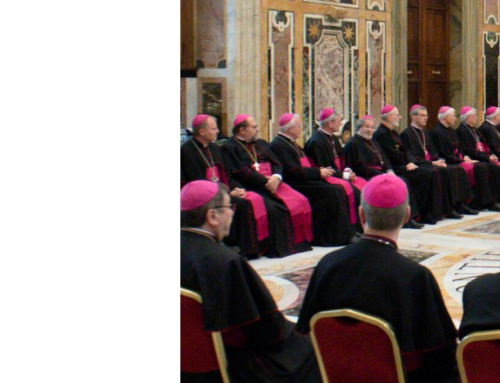Catholic League president Bill Donohue comments on the findings of an important Irish report on Irish nuns:
Another interim report by Ireland’s Commission of Investigation of the Mother and Baby Homes has been released, and it debunks some myths perpetrated by the critics of the Sisters of Bon Secours in Tuam, a town in County Galway. It also vindicates the position of the Catholic League.
Katherine Zappone, Ireland’s Minister for Children and Youth Affairs, said there is “little basis for the theory that rather than having died, the children were ‘sold’ to America.” In fact, the report explicitly notes that “there is no evidence whatsoever that could support that theory.”
The report also shoots a hole in the theory that the remains of nearly 800 children were found in a septic tank on the grounds of the Mother and Baby Home. It concluded that “human remains found by the commission are not in a sewage tank.”
The Irish, English, and American media have dealt with these two issues dishonestly. Only the Irish Times made mention of the babies hoax; only the Irish Independent cited the sewage tank hoax; only the New York Times mentioned both. Those who depend on the BBC, and most American news sources, have been kept in the dark.
In this country, for the past several years, no media outlet swallowed the moonshine about both hoaxes more than Irish Central. Now that the report is out it is harder to do so. Irish Central has since acknowledged that the babies were not sold, but has still not owned up to its role in promoting the lie that the remains of 796 children were found in a septic tank.
No one floated the vicious lie that the nuns sold abandoned children to Americans more than Martin Sixsmith, Steve Coogan, Judi Dench, and the Hollywood crowd.
Sixsmith wrote the book about Philomena Lee, Coogan did the screenplay adaptation, and Dench played her character in the movie, “Philomena.” The number of bald face lies told about the nuns is staggering. Take, for example, an interview that Coogan granted to MSNBC in 2014 about the movie.
Richard Liu, the host, said at one point, “And you’re talking about a group of girls and women, out-of-wedlock, having children in these institutions [homes run by nuns for troubled young women], and their children were taken away from them.”
This is a lie: the nuns did not walk the streets of Ireland seeking to rob kids from their mothers. In the case of Philomena, her father took her to the nuns to care for the baby she could not provide for.
Coogan replied to Liu that the home was “the only place that you could go to.” He is correct about this: no one was kidnapped—the women came to the nuns voluntarily. Moreover, the alternative was the street. Lucky for Philomena, her father placed her with the nuns—the same nuns who found her a job after her baby was born.
Coogan said these women were “effectively incarcerated against their will.” This is a lie: no one was “incarcerated”; Philomena did not live in a jail cell. The word “effectively” is interesting: either they were imprisoned or they were not. Coogan also says “their children were forcibly adopted.” This is another lie: Philomena voluntarily signed a contract when she was 22. No one “forced” her to give up her baby.
Liu says, “And then [the nuns] prevented [the women] from finding their children.” Coogan says that in Philomena’s case, “she was obstructed at every turn by both the government and the Church.” Two more lies: the Church didn’t stop anyone, and Philomena never set foot in the U.S. until 2013; this was long after her son died of AIDS. Contrary to what the film contends, she never looked for her son in the U.S.
It must also be noted that the babies were never “sold” to anyone, never mind the “highest bidder.” Did some American couples offer a donation to the nuns for their services? Of course. But one must be a fool not to recognize the difference between offering cash to buy a baby and writing a check as an expression of appreciation.
Regarding the “mass grave” sewage-tank hoax, anyone who was not an ideologue should have been able to figure that one out a long time ago.
In 2014, a reporter for the New York Times, Ed O’Loughlin, wrote that “a dogged local historian,” Catherine Corless, “published evidence” that 796 children died in the Tuam Mother and Baby Home, and that the remains of “some” were found in the septic tank. In fact, Corless is not an historian—she is a typist.
Interestingly, the official statement by the Mother and Baby Commission, issued on March 3, 2014, made no mention of a “mass grave.” Why not? If there were evidence of a mass grave surely that would have been the lead story. Instead, it says “significant quantities of human remains” were found in sewage chambers. That is disturbing but it does not support the wild claims of a “mass grave.”
Consider, too, that on July 12, 2016, another government interim report was issued and it, too, said nothing about any “mass grave.” It must be mentioned that even Corless, the source of the “mass grave” allegation, made no mention of any “mass grave” when she wrote about her findings in a 2012 article titled, “The Home”; it was published in the Journal of the Old Tuam Society.
Corless not only failed to mention a “mass grave,” she offered evidence that undermined her thesis. She wrote that, “A few local boys came upon a sort of crypt in the ground, and on peering in they saw several small skulls.” She mentioned there was a “little graveyard.” That is not the makings of a mass grave.
Corless said in 2014, “I am certain there were 796 children in a mass grave.” She offered no evidence, nor did she explain why—just two years earlier—she said there were “several small skulls” in a “little graveyard.”
The primary source for Corless’ “mass grave” thesis is Barry Sweeney. When he was 10, he and a friend stumbled on a hole with skeletons in it. In 2014, he was asked by the Irish Times to comment on Corless’ claim that there were “800 skeletons down that hole.” He said, “Nothing like that.” How many? “About 20,” he said. He later told the New York Times there were “maybe 15 to 20 small skeletons.” In other words, Corless’ primary source contradicts her account!
When this story broke in 2014, Ireland’s Minister for Education, Ruairi Quinn, said the Corless account was “simply not true.” The local police said at that time that “there is no confirmation from any source that there are between 750 and 800 bodies present.”
Now that the latest Interim report has debunked the sewage tank thesis, Corless is trying to put a happy face on it. She said she is “very, very, pleased” with the report. The source of her happiness? She agrees with Zappone that some individuals must know more about what happened. That’s it? Yes. Not exactly something to hang your hat on.
The Church haters, naturally, are not going away, though even they must concede that no babies were sold and no septic tank strewn with bodily remains has been found. Still, there are holdouts.
We are now learning that there are some pictures that accompany the report, most of which have been redacted, that are allegedly troubling. Ready for the smoking gun? A blue baby shoe has been found at the Tuam site.
Look for Corless, the “dogged local historian,” to track down the other shoe and then declare victory. Such is life in the loser’s lane.
The media are not flagging this story because to do so would draw attention to their own biased coverage all along. So we are doing it. Score one for the Catholic League.







